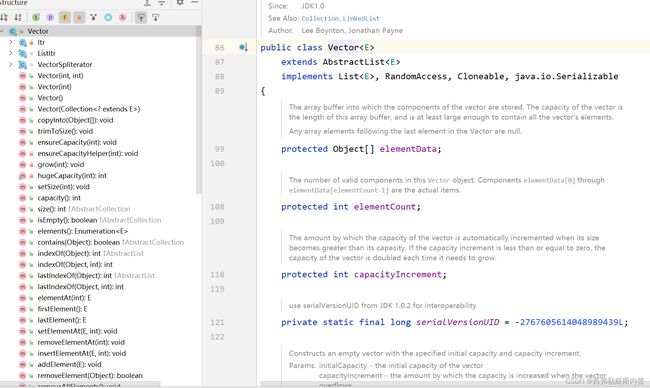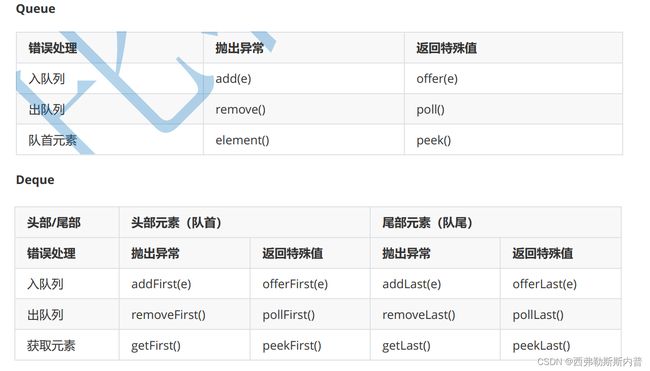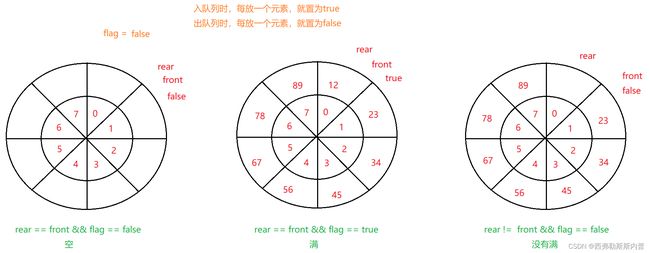【Java数据结构】栈和队列
- 一、 栈(Stack)
-
- 1、概念
- 2、入栈和出栈的顺序
- 3、中缀表达式转后缀表达式
- 4、栈的方法
-
- LeetCode 150. 逆波兰表达式求值
- 剑指 Offer 31. 栈的压入、弹出序列
- 5、栈的实现
-
- LeetCode 20. 有效的括号
- LeetCode 155. 最小栈
- 二、队列
-
- 1、普通队列 与 双端队列
- 2、单链表实现队列
- 3、 循环队列
-
- 如何区分空与满:
- LeetCode 622. 设计循环队列
- LeetCode 225. 用队列实现栈
- LeetCode 232. 用栈实现队列
一、 栈(Stack)
1、概念
栈:一种特殊的线性表,其只允许在固定的一端进行插入和删除元素操作。进行数据插入和删除操作的一端称为栈顶,另一端称为栈底。栈中的数据元素遵守后进先出LIFO(Last In First Out)的原则。
压栈:栈的插入操作叫做进栈/压栈/入栈,入数据在栈顶。
出栈:栈的删除操作叫做出栈。出数据在栈顶。
栈的特点是 先进后出
Java虚拟机栈:JVM stack 是JVM中的一块内存,调用函数的时候,在JVM stack 开辟一块内存,叫做栈帧
2、入栈和出栈的顺序
一个栈的入栈序列是a b c d e,栈不可能出栈序列为():
A. edcba
B.decba
C.dceab
D.abcde
一个栈的入栈序列是m n x y z,栈不可能出栈序列为():
A. mnxyz
B. xnyzm
C. nymxz
D. nmyzx
了解了栈的概念,解决以上问题
解释:1. 入栈a b c d 此时d c出栈,e没有,入栈再出栈,下一个a要出栈,先要出b,顺序应该是ba,所以答案C错误
2. 同样,答案C中,第一个出n,所以m压栈,n压栈再出栈,接着x压栈,y压栈再出栈,下一个要出m先得出x
3、中缀表达式转后缀表达式
例如:求 (5 + 4) * 3 - 2的后缀表达式
做法:先按照运算顺序加括号,再将所有运算符放到括号后,最后去除我们加上的括号
(((5 + 4) * 3) - 2)
(((5 4)+ 3)* 2)-
5 4+ 3 * 2 -
如果通过这个后缀表达式求值?
用 i 遍历这个表达式,数字压栈,遇到运算符,弹出栈顶的两个元素,第一个放在运算符右边,否则减法就会错顺序
4、栈的方法
public static void main(String[] args) {
Stack<Integer> stack = new Stack<>();
// 压栈
stack.push(11);
stack.push(22);
stack.push(33);
// 弹出栈顶元素,并删除
System.out.println(stack.pop()); // 33
// 获取栈顶元素,但不删除
System.out.println(stack.peek()); // 22
// 是否为空
System.out.println(stack.empty()); // false
// 查找
System.out.println(stack.search(22)); // 1
Deque<Integer> stack1 = new ArrayDeque<Integer>();
}
继承的方法等:
LeetCode 150. 逆波兰表达式求值
150. 逆波兰表达式求值
根据 逆波兰表示法,求表达式的值。
有效的算符包括 +、-、*、/ 。每个运算对象可以是整数,也可以是另一个逆波兰表达式。
说明:
整数除法只保留整数部分。
给定逆波兰表达式总是有效的。换句话说,表达式总会得出有效数值且不存在除数为 0 的情况。
示例 1:
输入:tokens = [“2”,“1”,“+”,“3”,“*”]
输出:9
解释:该算式转化为常见的中缀算术表达式为:((2 + 1) * 3) = 9
class Solution {
public int evalRPN(String[] tokens) {
Stack<Integer> stack = new Stack<>();
for(int i = 0; i < tokens.length; i++) {
String val = tokens[i];
if(!isOperation(val)) {
// 不是运算符
stack.push(Integer.parseInt(val)); // 转为数字
} else {
// 是运算符 计算
int num1 = stack.pop();
int num2 = stack.pop();
switch(val) {
case "+":
stack.push(num2 + num1);
break;
case "-":
stack.push(num2 - num1);
break;
case "*":
stack.push(num2 * num1);
break;
case "/":
stack.push(num2 / num1);
break;
}
}
}
return stack.pop();
}
private boolean isOperation(String x) {
if(x.equals("+") || x.equals("-") || x.equals("*") || x.equals("/")) {
return true;
}
return false;
}
}
剑指 Offer 31. 栈的压入、弹出序列
剑指 Offer 31. 栈的压入、弹出序列
输入两个整数序列,第一个序列表示栈的压入顺序,请判断第二个序列是否为该栈的弹出顺序。假设压入栈的所有数字均不相等。例如,序列 {1,2,3,4,5} 是某栈的压栈序列,序列 {4,5,3,2,1} 是该压栈序列对应的一个弹出序列,但 {4,3,5,1,2} 就不可能是该压栈序列的弹出序列。
示例 1:
输入:pushed = [1,2,3,4,5], popped = [4,5,3,2,1]
输出:true
解释:我们可以按以下顺序执行:
push(1), push(2), push(3), push(4), pop() -> 4,
push(5), pop() -> 5, pop() -> 3, pop() -> 2, pop() -> 1
class Solution {
public boolean validateStackSequences(int[] pushed, int[] popped) {
Stack<Integer> stack = new Stack<>();
int j = 0;
for(int i = 0; i < pushed.length; i++) {
stack.push(pushed[i]); // 遍历pushA数组 放入栈中
// 循环判断 栈顶元素和当前 j 下标是否一样 一样就弹出
while(!stack.empty() && j < popped.length && stack.peek() == popped[j]) {
stack.pop();
j++;
}
}
return stack.empty();
}
}
5、栈的实现
public class MyStack {
public int[] elem;
public int usedSize;
public MyStack() {
this.elem = new int[5];
}
public void push(int val) {
if(isFull()) { // 2被扩容
this.elem = Arrays.copyOf(this.elem, 2*this.elem.length);
}
this.elem[this.usedSize] = val;
this.usedSize++;
}
// 判断数组满
public boolean isFull() {
return this.usedSize == this.elem.length;
}
public int pop() {
if(isEmpty()) {
throw new RuntimeException("栈为空");
}
int oldVal = this.elem[usedSize - 1];
this.usedSize--;
return oldVal;
}
public int peek() {
if(isEmpty()) {
throw new RuntimeException("栈为空");
}
return this.elem[usedSize - 1];
}
// 判断空
public boolean isEmpty() {
return this.usedSize == 0;
}
}
LeetCode 20. 有效的括号
20. 有效的括号
给定一个只包括 ‘(’,‘)’,‘{’,‘}’,‘[’,‘]’ 的字符串 s ,判断字符串是否有效。
有效字符串需满足:
左括号必须用相同类型的右括号闭合。
左括号必须以正确的顺序闭合。
示例 1:
输入:s = “()”
输出:true
class Solution {
public boolean isValid(String s) {
Stack<Character> stack = new Stack<>();
for(int i = 0; i < s.length(); i++) {
char ch = s.charAt(i);
if(ch == '(' || ch == '{' || ch == '[') {
// 左括号 入栈
stack.push(ch);
} else {
// 右括号 匹配
if(stack.empty()) {
return false; // 右括号多
}
char top = stack.peek(); // 栈顶元素
if(top == '(' && ch == ')' || top == '[' && ch == ']' || top == '{' && ch == '}') {
stack.pop();
} else {
return false; // 左右括号不匹配
}
}
}
return stack.empty(); // 不为空 左括号多
}
}
LeetCode 155. 最小栈
155. 最小栈
设计一个支持 push ,pop ,top 操作,并能在常数时间内检索到最小元素的栈。
push(x) —— 将元素 x 推入栈中。
pop() —— 删除栈顶的元素。
top() —— 获取栈顶元素。
getMin() —— 检索栈中的最小元素。
示例:
输入:
[“MinStack”,“push”,“push”,“push”,“getMin”,“pop”,“top”,“getMin”]
[[],[-2],[0],[-3],[],[],[],[]]
输出:
[null,null,null,null,-3,null,0,-2]
class MinStack {
// private Stack stack = new Stack<>();
// private Stack minStack = new Stack<>();
Stack<Integer> stack;
Stack<Integer> minStack;
public MinStack() {
stack = new Stack<>();
minStack = new Stack<>();
}
public void push(int val) {
stack.push(val);
if(!minStack.empty()) { // 不为空
int top = minStack.peek(); // 判断minStack是否要加入
if(val <= top) { // 小于等于 也要放进去
minStack.push(val);
}
} else {
minStack.push(val);
}
}
public void pop() {
int popVal = stack.pop();
if(!minStack.empty()) {
int top = minStack.peek();
if(top == popVal) { // 判断minStack是否要删除
minStack.pop();
}
}
}
public int top() {
return stack.peek();
}
public int getMin() {
return minStack.peek();
}
}
二、队列
1、普通队列 与 双端队列
队列:(queue)只允许在一端进行插入数据操作,在另一端进行删除数据操作的特殊线性表,队列具有先进先出FIFO(First In First Out) 入队列:进行插入操作的一端称为队尾(Tail/Rear) 出队列:进行删除操作的一端称为队头
(Head/Front)
双端队列:(deque)是指允许两端都可以进行入队和出队操作的队列,deque 是 “double ended queue” 的简称。
那就说明元素可以从队头出队和入队,也可以从队尾出队和入队。
import java.util.Deque;
import java.util.LinkedList;
import java.util.Queue;
public class TestDemo {
public static void main(String[] args) {
Queue<Integer> queue = new LinkedList<>();
// 入队列
queue.add(1); // 容量限制 -> 可能对抛异常
queue.offer(2);
// 获取队首元素
System.out.println(queue.peek()); // 1
System.out.println(queue.element()); // 1
// 出队列
System.out.println(queue.poll()); // 1
System.out.println(queue.remove()); // 2
System.out.println("================");
Deque<Integer> queue2 = new LinkedList<>();
queue2.offerFirst(1);
queue2.offerFirst(2);
queue2.offer(3); // 默认队尾入队
// 2 1 3
System.out.println(queue2.peek()); // 2 默认获取队首元素
System.out.println(queue2.peekFirst()); // 2
System.out.println(queue2.peekLast()); // 3
}
}
2、单链表实现队列
对LinkedList来说,不仅可以当做普通的队列,也可以当做双端队列,也可以当做双向链表,也可以当做栈。
用单链表来实现队列,用一个last 指针实现时间复杂度O(1)
class Node {
public int val;
public Node next;
public Node(int val) {
this.val = val;
}
}
public class MyQueue {
public Node head;
public Node last;
/**
* 尾插
* @param val
*/
public void offer(int val) {
Node node = new Node(val);
if(this.head == null) {
this.head = node;
last = node;
} else {
last.next = node;
last = last.next;
}
}
/**
* 出队列
* @return
*/
public int poll() {
if(isEmpty()) {
throw new RuntimeException("队列为空");
}
int oldVal = head.val;
this.head = head.next;
return oldVal;
}
public boolean isEmpty() {
return this.head == null;
}
public int peek() {
if(isEmpty()) {
throw new RuntimeException("队列为空");
}
return head.val;
}
}
// 测试:
public static void main(String[] args) {
MyQueue queue = new MyQueue();
queue.offer(1);
queue.offer(2);
queue.offer(3);
System.out.println(queue.poll()); // 1
System.out.println(queue.poll()); // 2
System.out.println(queue.poll()); // 3
}
3、 循环队列
如何区分空与满:
-
第一种解决方式:使用usedSize.使用usedSize和数组长度比较,确定满或者空。
-
第二种解决方式:使用标志位
- 第三种解决方式:保留一个位置 front == rear
每次存放元素之前,都先检查一下rear的下一个是不是front。如果是那么就是满的。
LeetCode 622. 设计循环队列
622. 设计循环队列
你的实现应该支持如下操作:
MyCircularQueue(k): 构造器,设置队列长度为 k 。
Front: 从队首获取元素。如果队列为空,返回 -1 。
Rear: 获取队尾元素。如果队列为空,返回 -1 。
enQueue(value): 向循环队列插入一个元素。如果成功插入则返回真。
deQueue(): 从循环队列中删除一个元素。如果成功删除则返回真。
isEmpty(): 检查循环队列是否为空。
isFull(): 检查循环队列是否已满。
class MyCircularQueue {
public int[] elem;
public int front; // 对头下标
public int rear; // 队尾下标
public MyCircularQueue(int k) {
this.elem = new int[k + 1]; // k + 1
}
// 入队列
public boolean enQueue(int value) {
if(isFull()) return false;
this.elem[rear] = value;
rear = (rear + 1) % elem.length;
return true;
}
// 出队列
public boolean deQueue() {
if(isEmpty()) return false;
front = (front + 1) % elem.length;
return true;
}
// 得到队头元素
public int Front() {
if(isEmpty()) return -1;
return elem[front];
}
// 得到队尾元素
public int Rear() {
if(isEmpty()) return -1;
int index = -1;
if(rear == 0) {
index = elem.length - 1;
} else {
index = rear - 1;
}
return elem[index];
}
public boolean isEmpty() {
return front == rear; // 相遇
}
public boolean isFull() {
// rear 的下一个是 front
if((this.rear + 1) % elem.length == front) {
return true;
}
return false;
}
}
LeetCode 225. 用队列实现栈
225. 用队列实现栈
// 入栈时,入到不为空的队列,都为空就指定一个
// 出栈时,在不为空的队列,出 size - 1 个元素,剩下的一个就是要出栈的元素
public class MyStack {
public Queue<Integer> qu1;
public Queue<Integer> qu2;
public MyStack() {
qu1 = new LinkedList<>();
qu2 = new LinkedList<>();
}
public void push(int x) {
if(!qu1.isEmpty()) {
qu1.offer(x);
} else if (!qu2.isEmpty()) {
qu2.offer(x);
} else {
qu1.offer(x); // 都为空 指定一个
}
}
public int pop() {
if(empty()) return -1;
if(!qu1.isEmpty()) {
int size = qu1.size();
for (int i = 0; i < size - 1; i++) {
int val = qu1.poll();
qu2.offer(val);
}
return qu1.poll();
}
if(!qu2.isEmpty()) {
int size = qu2.size();
for (int i = 0; i < size - 1; i++) {
int val = qu2.poll();
qu1.offer(val);
}
return qu2.poll();
}
return -1;
}
public int top() {
if(empty()) return -1;
if(!qu1.isEmpty()) {
int val = -1;
int size = qu1.size();
for (int i = 0; i < size; i++) {
val = qu1.poll();
qu2.offer(val);
}
return val;
}
if(!qu2.isEmpty()) {
int val = -1;
int size = qu2.size();
for (int i = 0; i < size; i++) {
val = qu2.poll();
qu1.offer(val);
}
return val;
}
return -1;
}
public boolean empty() {
return qu1.isEmpty() && qu2.isEmpty();
}
}
LeetCode 232. 用栈实现队列
添加链接描述
class MyQueue {
// 入队的时候,统一入到第1 个栈
// 出队的时候,统一出第2 个栈的元素,如果第二个栈为空,将第1 个栈的所有元素导入,再出栈顶元素,相当于倒了个顺序
public Stack<Integer> stack1;
public Stack<Integer> stack2;
public MyQueue() {
stack1 = new Stack<>();
stack2 = new Stack<>();
}
public void push(int x) {
stack1.push(x);
}
public int pop() {
if(empty()) return -1;
if(stack2.empty()) {
while(!stack1.empty()) {
// int val = stack1.pop();
// stack2.push(val);
stack2.push(stack1.pop());
}
}
return stack2.pop();
}
public int peek() {
if(empty()) return -1;
if(stack2.empty()) {
while(!stack1.empty()) {
stack2.push(stack1.pop());
}
}
return stack2.peek();
}
public boolean empty() {
return stack1.empty() && stack2.empty();
}
}



